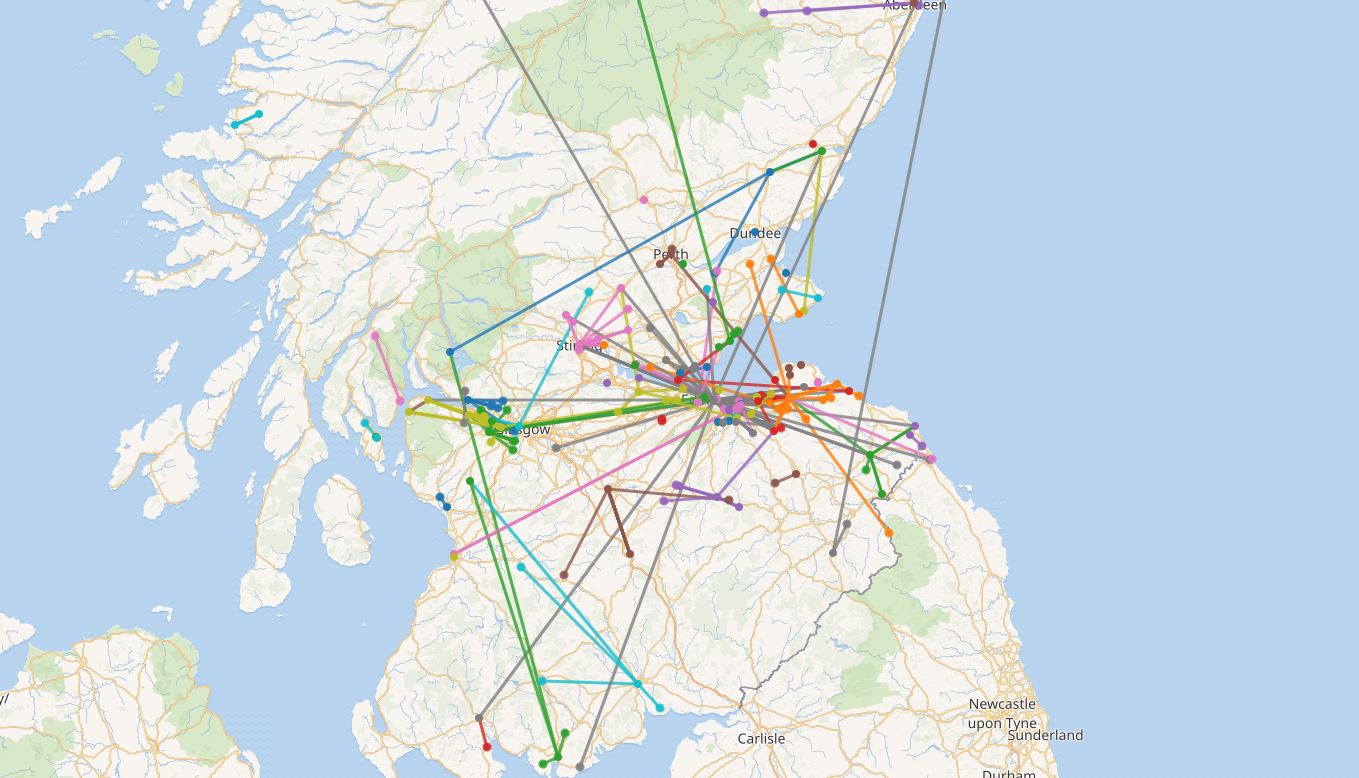This week I have been trying to get other geographical datasets located and ready to be visualised while finding more missing places of residence. Overall, it has been successful with the number of unfound places now totalling 37 from 821 original places. While there are other maps being produced about other aspects of the database – see places of detainment map here: https://w.wiki/5za
Working with other geographical data
Apart from accused witches places of residence, there are also other geographical locations recorded within the dataset which can also be visualised such as location of trial, detainment and execution.
These datasets are far smaller than the data recorded about accused witches location, this is because some areas were better at record keeping than others and so some information was not properly recorded. This means that the datasets are missing information and not showing the full story for all of Scotland. However, these datasets are still rich in data with a vast array of places which can still be used to help paint a picture of the locations that witch related events took place.
Furthermore, the locations for trials, imprisonment and execution tend to be in villages, towns or cities making it much easier to locate. Therefore, I was able to work through these datasets relatively quickly to find the different locations with ease. The easy to find locations paired with my newly acquired knowledge of using OpenRefine to upload data to Wikidata, has made working with these datasets a breeze.
So far I have worked on fully digitizing places of detainment and I have trial and execution locations nearly ready to be uploaded to Wikidata. Aside from these datasets there are still other geographical aspects which can also be added over the next few weeks.
Towards the end of this week, I have received some suggestions about ways to relate the different datasets together. So far a link between accused witches residence and detainment location has been established which is very interesting as it is easy to look at the data very differently once this relationship has been established – see linked map here: https://w.wiki/5zk.
More location finding
No week is complete without some more unfound locations being identified. This week Julian Goodare and Louise Yeoman (two of the creators of the Scottish Witchcraft dataset) aided in the location finding of more unidentified places.
I am amazed by the knowledge that these historians have with locating the different place names. They also had many ideas and sources for the identification of these places in ways that I would never think of which was extremely helpful in narrowing down the list.
It was also then suggested to me by Julian Goodare that rather than spending anymore of my time trying to find these hard to find settlements, that I rounded the location to parish which is the next most accurate location of these places. I then decided to change the residence for the accused witch to parish for the unfound locations that had the parish name recorded. This is because the parish still narrows the witches’ residence down to a town or village and so is more accurate than having no location for an accused witch’s residence. The change of rounding the settlements to the nearest parish has helped further narrow down the list of unfound places with now only 37 unfound places to go!
Full staff meeting
Aside from my general location finding, on Thursday afternoon there was a full staff meeting for the Information Services department. This meeting was basically a chance to meet new people from the department through doing different activities. The meeting was a nice way to spend a Thursday afternoon with an activity of building a bot – where we had to come up with ideas to build a chatbot.
Then we finished off the afternoon with some relaxing colouring in using homemade colouring books which feature the outline of different paintings that are owned by the University of Edinburgh. These booklets were produced by the Information Services department and the colouring book aims to help you de-stress by concentrating on drawing. Free copies of these books are found around campus and in different offices.
Next week, I aim to have more of the geographical information mentioned in the database uploaded onto Wikidata while thinking more about finding unfound places and having more ideas for visualising the data.



Leave a Reply